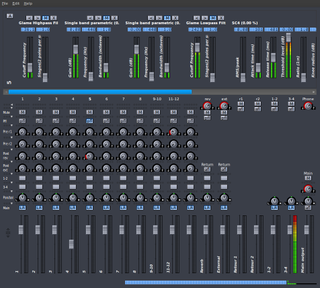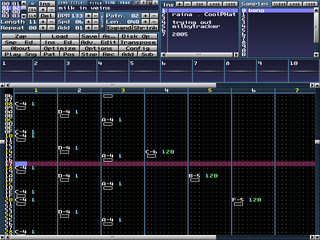Tom's Definitive Linux Software Roundup: Audio Production
Loopers, Trackers, And Mixers
Loopers

Freewheeling (v. 0.6)
Freewheeling is a live looping sampler. The user interface is extremely old, though other live looping samplers aren't very pretty either. There is no menu bar or toolbar. The main screen contains the entirety of the application, drawn in DOS-style graphics.
Up to eight loops are activated using color-coded blocks near the top of the window. Right and left clicks of the mouse activate, deactivate, lock, and disable these loops. Using JACK Control, Freewheeling can easily be connected to VMPK for input, and output directly to system playback or elsewhere in a more complex chain.




Kluppe (v. 0.6.14)
Kluppe is a live looping and recording application that supports multiple loops. Utilizing JACK Control, output from each loop can be sent separately to different inputs.
Starting a new usable loop requires a new buffer to be created and associated with it. When first opened, the user interface is plain, hosting a menu bar and buttons to start a new project. Creating a new looper opens the waveform and options for that loop. Loop options include output volume, recording/mix, ratio, playback start/end positions, playback loop length, recording start/end positions, record loop length, number of grains, grain density, L/R pan, and an autopanner. Unfortunately, none of these controls are labeled, requiring a mouse-over to reveal the tool tip label.
Stay on the Cutting Edge
Join the experts who read Tom's Hardware for the inside track on enthusiast PC tech news — and have for over 25 years. We'll send breaking news and in-depth reviews of CPUs, GPUs, AI, maker hardware and more straight to your inbox.



SooperLooper (v. 1.6.14)
SooperLooper is a live looping sampler application that requires JACK to function. SooperLooper can record audio from an input device like a microphone, instrument, or another app. Recorded audio can be looped and multiple loops can exist, though each requires new JACK connections. Recorded loops can also be overdubbed with more audio input. While it is possible to use SooperLooper live, it has been reported that using the keyboard/mouse to control it can make playing instruments at the same time quite difficult.
The UI in SooperLooper is unlike most other PC apps. Essentially a black screen filled with blue buttons, check boxes, and a few input fields, the color patterns and curved buttons make SooperLooper look like the LCARS interface from Star Trek. After tackling JACK connections, Sooper Looper is a pretty simple application to get up and running.




Mixers

LiveMix (v. 0.49)
LiveMix is a mixer application intended for technicians at live performances. The user interface greatly resembles a hardware mixer board, complete with knobs, sliders, buttons, and faux-LCD readouts. Some of the customizable controls include master EQ, gain, volume, pre-fader, post-fader, pan, balance, reverb, and independently controlled channel/output volume.
JACK connections to the system playback output were already made when starting LiveMix. The virtual keyboard function of ZynAddSubFX worked great for us as an input.


Trackers

MilkyTracker (v. 0.90.80)
MilkyTracker is an audio tracker application modeled after the popular FastTracker 2 DOS app. MilkyTracker works by adding notes from instruments and/or samples into a pattern editor, where patterns can be looped. Notes are entered using corresponding keys on the computer keyboard; most of the letter keys and half the number keys activate notes.
Instruments are saved as .xi files, while samples can be in .wav. This application also has a built-in synthesizer. Sound samples can be created by drawing a waveform and instruments can be created using a piano roll editor.







-
akorzan I found using WINE with, don't laugh, FL Studio works great. Latencies are on par with Windows. Only problem is some VST plugins have mouse problems... I.E: double-clicking has to be absurdly fast. Another trivial problem is that battery life in laptops is nonexistent with WINE and FL Studio.Reply -
longshotthe1st Why would anyone even bother? Time is money, I'm going to just stick with what works.Reply -
damiensturdy Great read. FLStudio is one of only two pieces of software that keeps me tied to Windows. Sure, it runs under Wine, but getting it working is a pain, and you're lucky to get 100% of the functionality. As an advanced user of FLStudio, I use almost everything the app provides, and I need it as low latency as possible. 20ms is too much- 10ms is better. In general I've never achievedReply -
damiensturdy Damn, it cut my post off. No way to edit that? ah well. I was basically saying that this article has helped me decide what software to use when I build my synthesizer this year.Reply -
g00ey Has anyone tried running software such as FL Studio in Linux using a virtualization software such as VirtuaBox? VirtualBox can even run in seamless mode which allows you to have Windows windows next to Gnome/KDE windows in the same screen.Reply -
Very nice article you could also have covered comercial productos on Linux like:Reply
Harrison Mixbus; Renoise; EnergyXT; WusikStation; PianoTec...
BTW there is big updates soon for Ardour (3.0), MuSe (2.0) and Rosegarden (?). -
damiensturdy @g00ey, yes. Latency and audio are weak through a VM, and the audio still has to travel through whichever audio library the Linux distro is using, it's a no go.Reply -
caeden g00ey, as a general rule of thumb you don't want to virturalize your workstations whether they be for audio or video editing. In part due to stability, and in part due to speed/latency.Reply
I was surprised at the scoring software. Looks about as good as my wife's version of Sibelius, with the exception that she had to pay for hers.
Personally I just do editing and cleanup, and while it looks like it is much improved on Linux from what it use to be, it has improved more on the windows side. But nice to know that there are options available if I were to ever cross over. -
I'm really looking forward to the Video apps review since that is my main sphere of interest.Reply
But it really sounds like it is time to get the 'ole midi keyboard out of the closet and try some of those synth apps!
Most Popular

